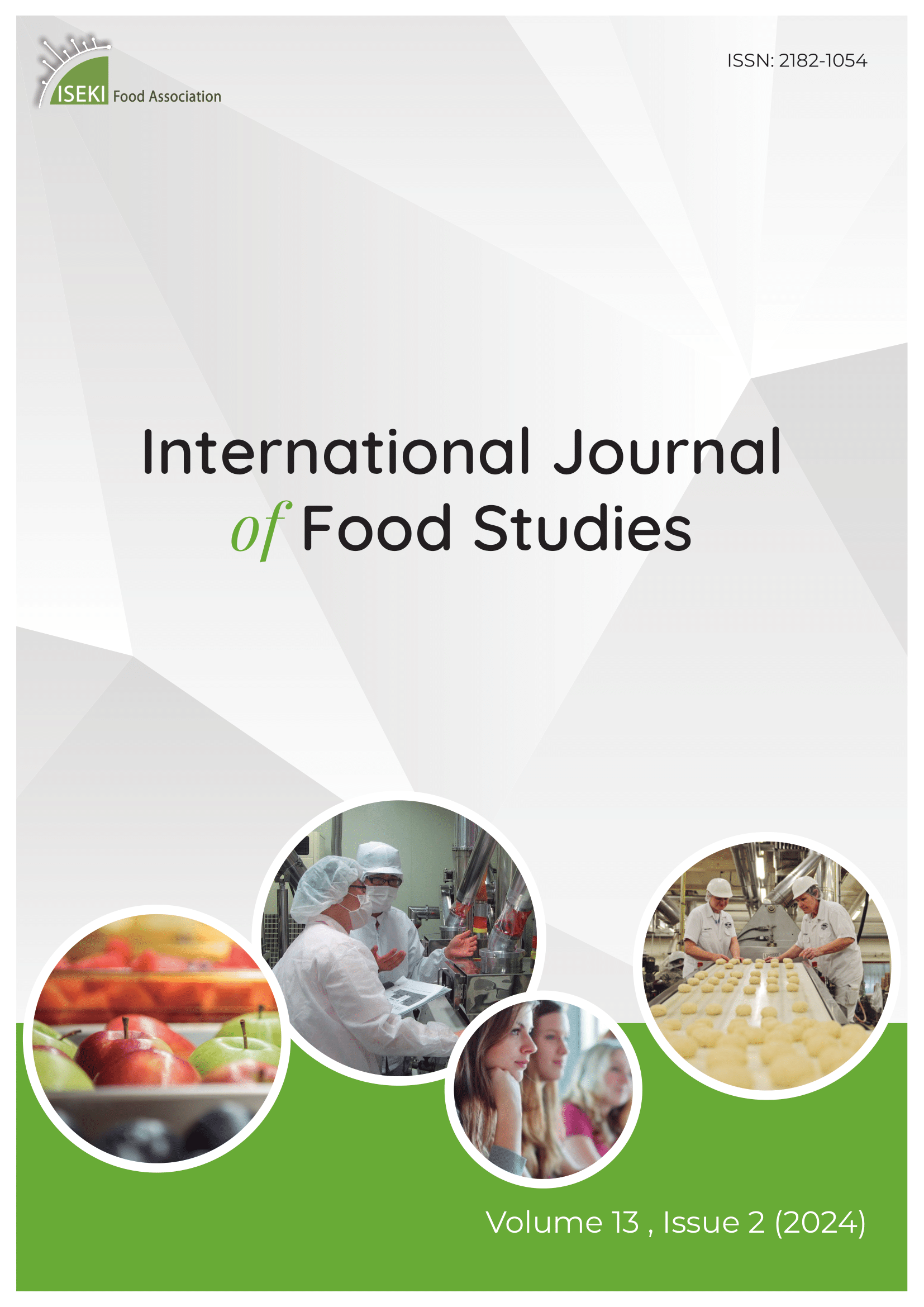Current issue

Volume 13, Issue 2, 2024
Online ISSN: 2182-1054
Volume 13 , Issue 2, (2024)
Published: 18.10.2024.
Open Access
All issues
Contents
18.10.2021.
Original scientific paper
Tetracycline resistance in enterococci and Escherichia coli isolated from fresh produce and why it matters
The contamination of fresh produce with antibiotic-resistant bacteria is of particular concern as they are often eaten raw and can be a source for foodborne diseases. Tetracyclines have been largely used in humans, animals and plants which might have accelerated microbial resistance to them. Enterococci and Escherichia coli can be used as indicators to monitor contamination of the fresh produce with tetracycline-resistant bacteria. The investigation related to this issue is very scarce in Oman. This study aimed at identifying tetracycline-resistant enterococci and E. coli in fresh produce at the market place. Thirty-one enterococci and ten E. coli were isolated from local (Oman) and imported fruits and vegetables (N= 105). Using the standard Kirby-Bauer disc diffusion method, resistance to tetracycline was found in 6 (19 %) enterococci, isolated from cucumber, lettuce and radish, and 5 (50 %) E. coli, obtained from cabbage, lettuce and radish. Genetic analysis revealed the presence of tetracycline resistance genes, tet(A) and tet(K), in E. coli and tet(K), tet(L) and tet(M) in enterococci, including Enterococcus sulfureus, Enterococcus mundtii, Enterococcus casseli avus and Enterococcus faecalis. The integron integrase IntI 1 gene, which is known to facilitate the dissemination of antibiotic resistance genes among bacteria, was detected in 2 isolates of E. coli. These results demonstrated the capability of fresh produce to act as a potential source for disseminating tetracycline or possibly other antibiotic-resistant bacteria through the food chain. Thus, control strategies are needed to reduce exposure of the public to such microorganisms.
Zahra Al-Kharousi, Nejib Guizani, Abdullah M. Al-Sadi, Ismail M. Al-Bulushi
18.10.2021.
Original scientific paper
Characterization of pasteurized milk spoilage by electronic nose in relation to its selected quality parameters
Pasteurized fresh milk requires an accurate estimation of shelf life under various conditions to minimize the risk of spoilage and product losses. Milk samples were stored for 56 h in an oven at 25°C and for 15 days in a refrigerator at 4°C. Samples were analyzed using an electronic nose (e-nose), total bacterial count, titratable acidity and pH to determine the quality of milk. Principal Component Analysis (PCA) and Linear Discriminant Analysis (LDA) were used to analyze e-nose data of milk stored at 25°C, and 4°C. A clear shift in quality was identified by the e-nose, which also appeared in the total bacterial count after 24 h and 12 days for storage at 25 and 4°C, respectively. On the other hand, titratable acidity exceeded the normal limits of 0.14 % - 0.21 % after 24 h for storage at 25°C (0.247 ± 0.006 %) and after 15 days for storage at 4°C (0.25 ± 0.01 %). If pH was a good indicator of quality for samples stored at 25°C, it showed no clear trends for samples stored at 4°C. Based on the microbial count data and e-nose output, the milk had a shelf life of 0.3 day (i.e. 8 h) when stored at 25°C. Shelf life was extended to 9 days when stored at 4°C.
Saleem Ehsan, Zahir Al-Attabi, Nasser Al-Habsi, Michel R. G. Claereboudt, Mohammad Shafiur Rahman
18.10.2021.
Original scientific paper
Effect of varying levels of acorn flour on antioxidant, staling and sensory properties of Iranian toast
Due to the high level of antioxidant activity of acorn fruits, they can be used as an ingredient the production of functional foods. The goal of the this research was to partially substitute wheat flour with varying levels (10% - 50% w/w) of debittered acorn flour and to investigate its effects on the rheological characteristics of the dough, total phenolic content (TPC), staling, colour indices and sensory properties of toast bread. The farinograph degree of softening and water absorption of the dough decreased with increasing the acorn flour content, while the stability and time of development of the dough increased. Resistance and extensibility to deformation of the samples respectively increased and decreased compared to those of the control. Toast bread with 30% acorn flour replacement was observed to have lower staling than the control. The highest TPC (9.44 mg GAE/g) and the lowest peroxide value (0.36 m eq O2/kg) were obtained for the bread having 30% acorn flour substitution. Moreover, the breads showed darker crumbs with significantly lower specific loaf volumes. Overall, the bread with 30% of acorn flour substitution showed good rheological, staling properties and reasonable anti-oxidant content compared to the control bread as well as the highest sensorial acceptability.
Babak Mousavi, sajad ghaderi, Mohammad Ali Hesarinejad, Azizollah Pourmahmoudi
18.10.2021.
Original scientific paper
Portfolio of beetroot (Beta vulgaris L.) peel extracts concentrated by nanofiltration membrane
Membrane process is an intelligent alternative way of concentration, preferably for organic juices rich in thermolabile natural components. The expectation is to scale up the extraction of desired compounds from agro-industrial wastes through modernized concentration method. Recovery of betalains, phenolic, and antioxidant from beetroot peel extracts was accomplished by nanofiltration membrane (NF 200) at a recirculation flow rate (400 L h-1) and feed temperature (30 ºC) under constant transmembrane pressure (40 bar). Characterization of betaxanthin, betacyanin, phenolic, and antioxidant activity by spectrophotometric analysis revealed that the final samples contain these compounds respectively: 202.25±3.26 mg.L-1, 360.07±8.43 mg.L-1, 987.79±19.18 mg.L-1, 642.06±14.78 mg.L-1 (pure water); 206.62±1.37 mg.L-1, 339.72±2.89 mg.L-1, 972.72±47.49 mg.L-1, 745.97±25.45 mg.L-1 (ethanol-water). Final samples exhibit vivid colour and a considerably large amount of desired compounds compared to crude extracts and could have industrial applications.
Zin Moh Moh, Szilvia Bánvölgyi
18.10.2021.
Original scientific paper
Response surface analysis and process optimization of non-cereal (elephant foot yam, taro and water chestnut) snacks
The present study was conducted to develop non-cereal starch extruded products. The effects of feed moisture (15-21%), temperature (130-170 °C) and screw speed (120-160 rpm) were evaluated on the physical and functional properties of extruded snacks using response surface methodology. Feed moisture and screw speed increased the bulk density and hardness of extruded snacks. Significant decreases in water absorption index and increases in water solubility index were observed with increases in extrusion temperature. The best conditions were determined by numerical optimization. The optimized value for non-cereal snacks for feed moisture is 18.22%, temperature 155.96 °C, screw speed 142.75 rpm and, desirability is 0.75. Verification of results showed decent agreement between the responses of experimental values at certain optimum conditions and the predicted values.
Anuj Saklani, Ravinder Kaushik, Krishan Kumar
18.10.2021.
Original scientific paper
Effects of addition of swine skin on the technological characteristics of mortadella produced in an industrial unit
The aim of this work was to evaluate the effects of the addition of swine skin on the technological characteristics of mortadella formulations produced on industrial scale. The effects of concentrations of swine skin (1.5 to 5.5 %) and sodium chloride (2 to 3 %) on total protein, total fat, starch, moisture, water activity, sodium, pH and texture profile (hardness, adhesiveness, elasticity, cohesiveness and chewiness) were evaluated and compared to a mortadella formulation without swine skin addition. The mortadella formulations with addition of 3.5 to 5.5 % swine skin and 2 to 2.5 % sodium chloride are in accordance with Brazilian legislation and provided an increase of approximately 12 % in protein content, a decrease of 14 % in sodium content and a water activity less than 0.9488. The swine skin and sodium chloride provided stability to the mortadella and influenced its texture, mainly in hardness, elasticity and chewiness.
Karem Muraro, Jamile Zeni, Rogério Luis Cansian, Juliana Steffens, Eunice Valduga, Geciane Toniazzo Backes
18.10.2021.
Original scientific paper
Development of technology for the production of sausage produce using secondary collagen-containing raw materials
One of the main requirements for modern technologies is to expand the range of meat products by creating combined products with a balanced composition of food and biologically active substances. The purpose of the study was to develop a technology for the production of such combined meat products. The research used secondary meat raw materials of the meat processing industry: horse meat, flank and other beef muscle tissue of the second grade, which, after fermentation by a consortium of microorganisms consisting of the following cultures: Lactobacillus bulgaricus, Bifidumbacterium siccum, Staphilococcus carnosus, were used instead of the main meat raw materials in the production of sausages. The following indicators of ready-prepared products were studied: organoleptic properties, chemical, vitamin and mineral composition, toxicity and harmlessness, storage duration. The results showed that the use of this consortium of microorganisms in the production of sausage products made it possible to use secondary collagen-containing raw materials for processing. The positive influence of the proposed biotechnological method of processing meat raw materials on the organoleptic, physical-chemical, structural-mechanical, microbiological characteristics and biological value of the finished product was revealed. It was found that the use of a consortium of microorganisms increased the quality of finished products. In addition, the proposed technology has the potential to reduce the cost of production and increase the share of waste-free production in the meat processing industry.
Natalia Gizatova, Albert Gizatov, Liliya Zubairova, Irina Mironova, Azat Nigmatyanov, Yuliya Chernyshenko, Alexey Pleshkov
18.10.2021.
Original scientific paper
Characterization of total phenol and flavonoid contents, colour, functional properties from honey samples with different floral origins
Honey has long been used as a food and has been reported to have potential health benefits. In this work, total phenol content, colour and antioxidant and hepatoprotective activities of honey samples of different floral origins from the State of Hidalgo, Mexico were explored using in vitro assays. Hepatoprotective activity was measured by inhibitition of β-glucuronidase; gastroprotective activity was determined by inhibition of urease; antioxidant activity was evaluated by 2,2'-Azino-bis-3-ethylbenzothiazoline-6-sulfonic acid (ABTS) and 2, 2-diphenyl-1-picrylhydrazyl (DPPH) methods. All the parameters showed significant differences (p<0.05) among honey samples. The total phenolic content ranged from 18.02 to 102.77 mg GAE 100 g-1. The colour ranged from extra light amber to dark amber. Inhibition of β-glucuronidase ranged from 23.70% to 36.00%, while urease inhibition ranged between 7.64% and 63.80%. The antioxidant activity by ABTS was between 44.68 and 441.56 mg AAE 100 g-1, and DPPH showed activities ranging from 35.64 to 573.06 mg AAE 100 g-1. All honey samples contained bioactive compounds and displayed functional properties; therefore, the honeys from this region of Mexico offer attractive characteristics for their potential use in the food industry.
Alma Delia Hernández-Fuentes, David Chávez-Borges, Antonio de Jesús Cenobio-Galindo, Andrea Paloma Zepeda-Velázquez, Ana Cristina Figueira, Rubén Jiménez-Alvarado, Rafael Germán Campos-Montiel
18.10.2021.
Original scientific paper
Lessons from Japan: promoting underutilized food crops through tourism
For the first time in the XXI century, the number of people suffering from obesity worldwide surpassed the number of undernourished people. For many developing countries, this presented a so-called "double burden" of coping for over- and under-nourishment. At a rate of more than 50% of the population in Malaysia being either overweight or obese, the country is facing the most severe dietary crisis in East Asia. Often recognized as one of the healthiest populations worldwide and having a blue zone, Japan has managed to set a yardstick for countries around Asia. Hence the purpose of this study was to uncover the capacity for contribution and successful integration of traditional vegetables into Japanese daily food practices. Semi structured interviews were conducted together with participating observation with key informants to help understand the role of women in preserving and safeguarding traditional vegetables also known as 'sansai' in terms of farming and food preparation. In order to solve the unhealthy eating patterns among Malaysians, it is timely to start appreciating the contributions of the older generation in terms of wild edible usage and preparatory methods which can help alleviate the double burden of malnutrition among the population.
RACHEL THARMABALAN
18.04.2020.
Original scientific paper
Zizyphus lotus (L.) extracts as prebiotics in the aggregation and adhesion of probiotic and inhibition of pathologic bacteria from patients with colorectal cancer
The mucosal surfaces of the intestinal tract harbor a complex microbiota. Bacteria enter in contact with intestinal cells and bestow important nutritional, metabolic and protective functions which benefit the host. Various factors are able to alter the balances between different intestinal bacteria. Dysbiosis has been described in various pathologies and metabolic diseases in humans, such as cancer. Colorectal cancer pathology can benefit from gut microbial imbalance. Its overgrowth may lead to acute symptoms. An alternative strategy to restore this balance is the use of plant extracts which exhibit a prebiotic activity by stimulating of probiotic bacteria and antimicrobial activity against pathogenic bacteria colonization. The present study aims to evaluate the in vitro antioxidant and antibacterial activity of phenolic extracts (Aqueous extract "AE" and Methanolic extract "ME" ) from Zizyphus lotus. It aims also to investigate the effect of this extract as a prebiotic on the aggregation of probiotic and inhibitory effects of pathogenic bacteria isolated from faeces of patients with colorectal cancer. Phytochemical analysis of different extracts from Zizyphus lotus by HPLC showed that all are rich in phenolic compounds (225.40 mgAGE/gDW for AE and 63.04 mgAGE/gDW for ME extracts). Moreover, all extracts showed an important antioxidant activity (227 µg/ml for AE and 195 µg/ml for ME). These extracts also exhibited a significant prebiotic effect and antibacterial activity. Characterization of the in vitro effect of the aqueous extract showed that the percentage of autoaggregation and adhesion of probiotic and inhibitory effects of pathogenic bacteria increased in the presence of aqueous extracts.
Sara Ouldchikh, Aicha TirTouil, Boumédiene Meddah











